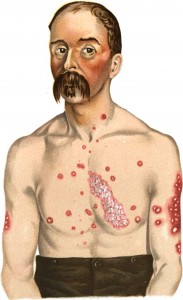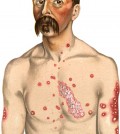- Psoriasis Cure: Great Alternatives To Standard Medical Treatments
- The Top 5 Nutrients To Include In Your Psoriasis Diet
- Skin Conditions: 8 Different Types Of Psoriasis
- Psoriasis Symptoms And The Various Treatments Available
- Scratching The Truth Behind Psoriasis And Psoriasis Causes
- Guttate Psoriasis: What Is It And How To Get Rid Of It?
- Why Should You Use An Eczema Cream?
- Which Eczema Treatment Should You Choose?
- What Is The Best Psoriasis Treatment?
- How To Treat Scalp Psoriasis Effectively?
How Psoriasis Vulgaris Is Diagnosed And Treated
Psoriasis vulgaris is the medical term for the most common form of psoriasis. “Vulgaris” is a Latin word meaning common. The other name of this type of psoriasis is plaque psoriasis because it resembles plaque formation on the surface of the skin.
It appears as defined patches of reddish raised bumps at any areas of the body. Yet, the most common areas that are affected are the knees, elbows, scalp, trunk, and nails.
Above the reddish raised bumps are the flaky white to silvery buildups called scales. The scales eventually come loose, shed, and detach from the skin. The skin of a person with psoriasis is extremely dry.
They may also feel pain, itching, and cracking of the skin. Due to tremendous itching, people with psoriasis tend to scratch their skin vigorously which leaves their skin wounded and prone to infections. Studies have shown that psoriasis is a result of an immune system disorder.
It is also noted that this illness may be inherited. Individuals with family history of psoriasis have increased risk for acquiring this disease. A child may have fifty percent chance of getting psoriasis if his or her parents are both positive for psoriasis.
Several other factors are associated in developing psoriasis vulgaris such as repetitive skin trauma or injury, prolonged sunlight exposure, stress, alcoholism, immunocompromised state, smoking, and intake of certain drugs such as steroids.
Psoriasis vulgaris is usually diagnosed through complete physical assessment and health history. Skin biopsies are also used to confirm the diagnosis of psoriasis. It used to rule out other integumentary or skin conditions not related to psoriasis.
Upon physical assessment, physician may note the general characteristics of plaque psoriasis such as plaques, reddish color, and scales. The plaque is an elevated skin lesion with a size of 1 or more centimetres. The usual shape of a plaque is oval but it can also be irregular.
Small plaques may merge with other plaques and form a large affected area. The red color of the affected area of skin is often termed as salmon-colored. The scales are silvery white and dry.
When scales are removed, the skin beneath them looks smooth, pinkish, and shiny. This glossy skin usually has areas that bleed. The symmetry of psoriatic plaques is parallel.
There are several non-traditional ways to treat psoriasis vulgaris. Meals that should be included in the diet are fish, celery, parsley, lettuce, limes, fruits, and vegetables. These strengthen the body and helps organs like liver and kidneys to function in good conditions.
A person with psoriasis should eliminate high animal fat diet because this promotes inflammation.
Warm salt water bath and soaking in warm water with German chamomile have proven effects to relieve itching or pruritus. It also helps to drink plenty of water (1-2 liters per day, if without cardiac problems).
This cleanses the body from toxins and gives moisture to skin. Taking supplements such as vitamin A and E are helpful as they promote healing process and tissue repair.
Lastly, a person with psoriasis should have positive attitudes. He or she must discipline himself or herself from scratching the skin. Itchy feeling usually subsides through distraction techniques, such as focusing oneself to many activities.










4 Comments